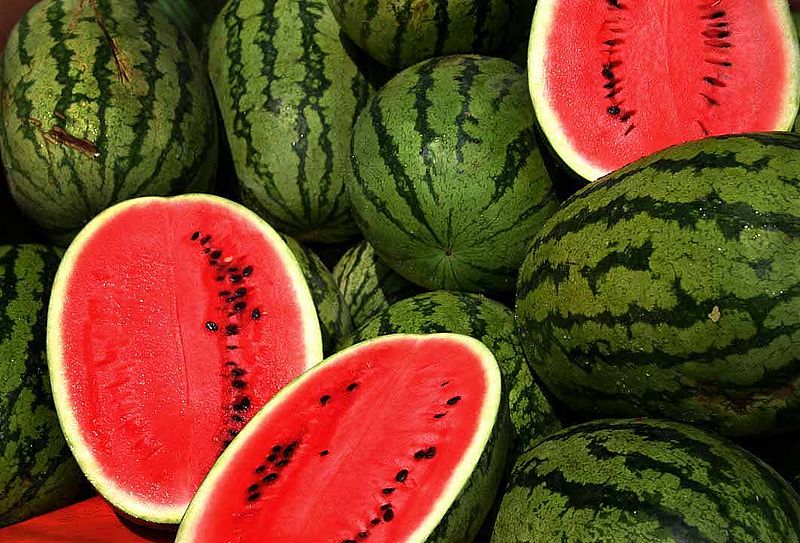
Watermelon Picking Tips, Festivals, Recipes, Canning Directions and Facts
Watermelon Facts, Picking Tips, Canning Directions and Recipes
Crops are great this year, all over!
Watermelons are one of the easiest fruit to prepare and serve. There's no peeling, pitting, coring or cutting. Just slice, bite, and spit!
 Picking
tips:
Picking
tips:
Select plump, full watermelons with a yellowish cast to the spot that rests on the ground and a dried stem. A hollow thud sound when gently rapped also helps!
Watermelon Measurements and Conversions
Keep in mind that watermelons vary in density and moisture content, so these ranges are approximates.
-
A normal batch of 10 eight-ounce jars watermelon jelly requires 6 cups of watermelon flesh, minus seeds and rinds. But the rinds can be used to make pickled watermelon rinds, so there is no waste. Especially if your children have fun spitting the seeds at each other, too!
- Once picked, put the watermelons in a cool, dry area out of direct sunlight.
- Want to grow your own watermelons? Here's an article from Ohio State University about how to: Growing Watermelons in the Home Garden, HYG-1626-95
-
Nutrition and miscellaneous facts: A watermelon contains about 6%
sugar and 91% water by weight. As with many other fruits, it is a source of
vitamin C. The amino-acid citrulline was first extracted from watermelon and
analyzed.
Watermelon rinds, usually a light green or white color, are also edible and contain many hidden nutrients but most people avoid eating them due to their unappealing flavor; except when pickled (pickled watermelon rinds are sweet and delicious!. See this page for the easy recipe). They are sometimes used as a vegetable, such as in China, where they are stir-fried, stewed or more often pickled. When stir-fried, the skin and fruit is removed, and the rind is cooked with olive oil, garlic, chili peppers, scallions, sugar and rum. Watermelon juice can be made into wine and into a delicious jelly - see this page for the easy watermelon jelly recipe. Watermelon is mildly diuretic and contains large amounts of carotenoids. Watermelon with red flesh is a significant source of lycopene. Preliminary research indicates the consumption of watermelon may have antihypertensive effects.
Varieties: There are more than 1200 varieties of watermelons, ranging in weight from less than one to more than 200 pounds; the flesh can be red, orange, yellow or white.[source: Wikipedia]
Watermelon nutritional values, raw
Nutritional value per 100 g (3.5 oz)
| Nutritional value per 100 g (3.5 oz) | |
|---|---|
| Energy | 127 kJ (30 kcal) |
| Carbohydrates | 7.55 g |
| - Sugars | 6.2 g |
| - Dietary fiber | 0.4 g |
| Fat | 0.15 g |
| Protein | 0.61 g |
| Water | 91.45 g |
| Vitamin A equiv. | 28 μg (4%) |
| - beta-carotene | 303 μg (3%) |
| Thiamine vit B | 0.033 mg (3%) |
| Riboflavin | 0.021 mg (2%) |
| Niacin | 0.178 mg (1%) |
| Pantothenic acid (B5) | 0.221 mg (4%) |
| Vitamin B | 0.045 mg (3%) |
| Choline | 4.1 mg (1%) |
| Vitamin C | 8.1 mg (10%) |
| Calcium | 7 mg (1%) |
| Iron | 0.24 mg (2%) |
| Magnesium | 10 mg (3%) |
| Manganese | 0.038 mg (2%) |
| Phosphorus | 11 mg (2%) |
| Potassium | 112 mg (2%) |
| Sodium | 1 mg (0%) |
| Zinc | 0.1 mg (1%) |
| Lycopene | 4532 µg |
| Link to USDA Database entry | |
Canning and preserving the watermelons:
Watermelon Festivals
Looking for canning equipment and supplies?
Water bath canner with a jar rack
Pressure canners for gas, electric and induction stoves: Presto 23Qt or T-fal 22Qt
Canning scoop (this one is PERFECT)
Ball Blue book (most recent version)
Jars: 8oz canning jars for jams
Find Other types of farms:
Farm markets and roadside stands
Road trips and camping resources
Local Honey, apiaries, beekeepers
Consumer fraud and scams information
Home canning supplies at the best prices on the internet!
Maple Syrup Farms, sugarworks, maple syrup festivals
Environmental information and resources
Farms For Your Event for birthday parties, weddings, receptions, business meetings, retreats, etc.
Festivals - local fruit and vegetable festivals
Get the
most recent version of
the Ball Blue Book
With this Presto 23 quart pressure canner and pressure cooker, you can "can" everything, fruits, vegetables, jams, jellies, salsa, applesauce, pickles, even meats, soups, stews. Model 01781

You can make jams, jellies, can fruit, applesauce, salsa and pickles with water bath canners, like this Granite Ware 12-Piece Canner Kit, Jar Rack, Blancher, Colander and 5 piece Canning Tool Set

